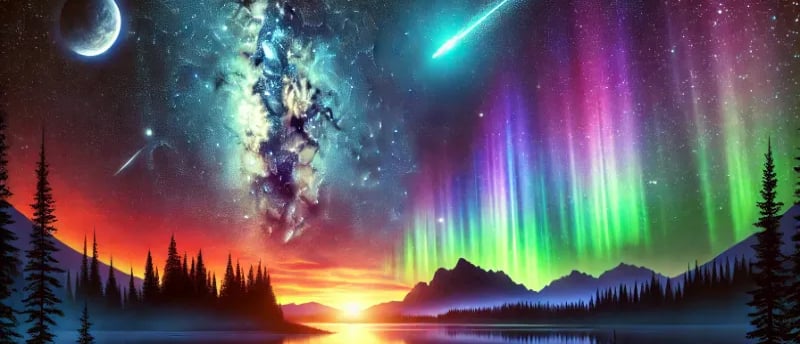Astronomical Phenomena: Wonders of the Universe
Explore the mysteries of astronomical phenomena, from eclipses and auroras to black holes and supernovae, and their role in science and human history.
GENERAL KNOWLEDGE
1/13/20252 min read


Astronomical phenomena captivate human curiosity, weaving tales of wonder and mystery across the cosmos. These events, both spectacular and subtle, showcase the dynamic and ever-changing nature of the universe. From the celestial ballet of planets to the cataclysmic explosion of a star, each phenomenon offers a glimpse into the vastness and complexity of space.
The Science Behind Astronomical Phenomena
At the heart of every astronomical phenomenon lies the intricate interplay of physics and celestial mechanics. Gravitational forces, electromagnetic interactions, and nuclear fusion create the stage for these cosmic events.
Scientists harness tools like telescopes and satellites to decode the mysteries of the universe, transforming awe-inspiring sights into opportunities for discovery.
Eclipses: Solar and Lunar Marvels
Eclipses are among the most well-known astronomical phenomena, occurring when one celestial body casts its shadow upon another. Solar eclipses, where the Moon obscures the Sun, are brief but mesmerizing, leaving observers spellbound.
Lunar eclipses, on the other hand, bathe the Moon in a reddish hue, a phenomenon often called the "blood moon." These events remind us of the precise alignment and harmony within our solar system.
Auroras: The Dance of Lights in the Sky
Auroras, the ethereal light displays near the polar regions, are a testament to the Sun’s influence on Earth. When charged solar particles interact with Earth’s magnetic field, they create curtains of shimmering light in hues of green, red, and violet.
These natural light shows, known as the aurora borealis and aurora australis, have inspired myths and scientific inquiry for centuries.
Comets and Meteors: Visitors from Space
Comets and meteors serve as cosmic messengers, bringing with them tales of the solar system's origins. Comets, with their icy nuclei and glowing tails, are periodic visitors that remind us of the vast expanse of our universe.
Meteors, often referred to as "shooting stars," are fragments of celestial debris burning up in Earth’s atmosphere, leaving fleeting streaks of light in the night sky.
Supernovae: The Death of Stars and Cosmic Renewal
Supernovae mark the dramatic end of a massive star's life, releasing an explosion of energy and light visible across vast distances.
These stellar deaths are not mere destruction; they are also the cradle of creation, dispersing elements like carbon and oxygen that form the building blocks of planets and life. Supernovae epitomize the cyclical nature of the cosmos.
Black Holes: Nature’s Cosmic Enigma
Black holes are regions of space where gravity is so intense that nothing, not even light, can escape. These enigmatic entities, born from the remnants of massive stars, challenge our understanding of physics and time.
The recent imaging of black holes has opened new frontiers in astronomy, sparking both fascination and further questions about the universe.
The Role of Astronomical Phenomena in Human History
Throughout history, astronomical phenomena have been both guiding lights and sources of fear. Ancient civilizations used the stars for navigation and agricultural planning, while comets were often seen as harbingers of doom. These events have left indelible marks on cultures, influencing art, literature, and religion.
Future Astronomical Events and Their Importance
The cosmos continues to promise extraordinary events for future generations. Solar eclipses, planetary alignments, and meteor showers captivate astronomers and enthusiasts alike.
These occurrences not only provide opportunities for scientific study but also unite humanity in a shared sense of wonder and appreciation for the universe.
The Everlasting Wonder of the Cosmos
Astronomical phenomena remind us of our place in the grand scheme of the universe. They inspire curiosity, drive exploration, and connect us to the infinite.
As we gaze at the night sky, we are reminded of the boundless beauty and complexity that define the cosmos, urging us to continue unraveling its secrets.
